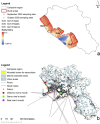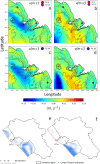GIS-based integration of marine data for assessment and management of a highly anthropized coastal area
- PMID: 40346072
- PMCID: PMC12064697
- DOI: 10.1038/s41598-025-00206-z
GIS-based integration of marine data for assessment and management of a highly anthropized coastal area
Abstract
Monitoring coastal marine environments by evaluating and comparing their chemical, physical, biological, and anthropogenic components is essential for ecological assessment and socio-economic development. In this study, we conducted an integrated multivariate analysis to assess the descriptors of the Marine Strategy Framework Directive at a regional scale in the Tyrrhenian Sea (Italy), with a specific focus on the densely populated coastal zone of the Campania region. Physical, chemical, and biological data were collected and analyzed in 22 sampling sites during three oceanographic surveys in the Gulf of Gaeta (GoG), Naples (GoN), and Salerno (GoS) in autumn 2020. Our results indicated that these three gulfs were distinct overall, with GoN being more divergent and heterogeneous than GoG and GoS. The marine area studied in the GoN had more favorable hydrographic and trophic conditions and food web characteristics, except for the mesozooplankton biomass, and was closer to socio-economic factors compared to the GoS and GoG. Our analysis helped us find the key ecological features that define different sub-regions and connect them to social and economic factors, including human activities. We highlighted the relevance of primary and secondary variables in terms of the comprehensive ecological assessment of a marine area and its impact on specific socio-economic activities. These findings support the need to describe and integrate multiple descriptors at the spatial scale.
Keywords: Campania region; Ecological assessment; Geographic information system; Good environmental status descriptors; Marine spatial planning; Marine strategy framework directive; Mediterranean basin; Spatial analysis.
© 2025. The Author(s).
Conflict of interest statement
Declarations. Competing interests: The authors declare no competing interests.
Figures







Similar articles
-
Polycyclic aromatic hydrocarbons in the sediments of the Gulfs of Naples and Salerno, Southern Italy: Status, sources and ecological risk.Ecotoxicol Environ Saf. 2018 Oct;161:156-163. doi: 10.1016/j.ecoenv.2018.05.077. Epub 2018 Jun 4. Ecotoxicol Environ Saf. 2018. PMID: 29879576
-
[Risk assessment of coastal ecosystem in Beibu Gulf, Guangxi of South China].Ying Yong Sheng Tai Xue Bao. 2011 Nov;22(11):2977-86. Ying Yong Sheng Tai Xue Bao. 2011. PMID: 22303677 Chinese.
-
Overview of integrative tools and methods in assessing ecological integrity in estuarine and coastal systems worldwide.Mar Pollut Bull. 2008 Sep;56(9):1519-37. doi: 10.1016/j.marpolbul.2008.07.005. Epub 2008 Aug 19. Mar Pollut Bull. 2008. PMID: 18715596 Review.
-
Marine monitoring: Its shortcomings and mismatch with the EU Water Framework Directive's objectives.Mar Pollut Bull. 2006;53(1-4):5-19. doi: 10.1016/j.marpolbul.2005.11.026. Epub 2006 Jan 19. Mar Pollut Bull. 2006. PMID: 16426645
-
Indicator Properties of Baltic Zooplankton for Classification of Environmental Status within Marine Strategy Framework Directive.PLoS One. 2016 Jul 13;11(7):e0158326. doi: 10.1371/journal.pone.0158326. eCollection 2016. PLoS One. 2016. PMID: 27410261 Free PMC article. Review.
References
-
- Livingston, R. J. Trophic organization in coastal systems. CRC Press (2002).
-
- He, Q. & Silliman, B. R. Climate change, human impacts, and coastal ecosystems in the anthropocene. Curr. Biol.29, R1021–R1035 (2019). - PubMed
-
- Selig, E. R. et al. Mapping global human dependence on marine ecosystems. Conserv. Lett.12, e12617 (2019).
-
- Halpern, B. S. et al. A global map of human impact on marine ecosystems. Science319, 948–952 (2008). - PubMed
-
- D’Alelio, D., Russo, L., Hay Mele, B. & Pomati, F. Intersecting ecosystem services across the aquatic continuum: From global change impacts to local, and biologically driven, synergies and trade-offs. Front. Ecol. Evol.9, 628658 (2021).
MeSH terms
LinkOut - more resources
Full Text Sources

